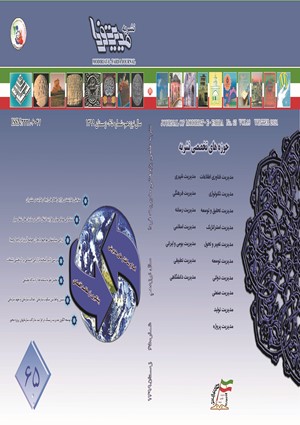-
-
List of Articles
-
Open Access Article
1 - Providing operational models to support local production in benchmarking from successful efforts in this field in the world.
seyyed alireza mirmohammad sadeghi iman sadeghzadeh -
Open Access Article
2 - Identify the appropriate approach to strategic planning in knowledge-based companies: Multiple case study
Bahman Hajipour Hamid Reza Yazdani Mohammad Asarian -
Open Access Article
3 - Explaining a model for sacrifice based on customer experience in the hotel industry (four and five stars in Shiraz)
jahanbakhsh rahimi baghmalek seyed abolghasem mira Mohammad Haghighi -
Open Access Article
4 - Identifying and Prioritizing Expectations of Internet Banking Users Using Fuzzy Multiple Criteria Decision Making
Masoud Moosavi Nezhad Alireza Shahraki -
Open Access Article
5 - Exploring and Explaining the Antecedents of Emotional Climate of Organization in National Iranian Oil Products Distribution Company
Mohammad Hossein Dehnavi ali shirazi Shamsodin Nazemi fariborz rahimnia -
Open Access Article
6 - Identifying and prioritizing the guideline principles of successful deployment of agile knowledge management with Delphi approach at growth centre of technician and knowledge based units at imam Hussein comprehensive university
Mahdi Farmani Jabar Babashahi Mohammad arabi Esmail laali -
Open Access Article
7 - The general model for lifecycle of R&D projects in research organizations with systems engineering approach
Mohammad forozandeh abbas tahmasebi taha hossein mortagi -
Open Access Article
8 - Investigation of the relationship between the managers narcissism with monitoring costs
ameneh bazrafshan ashraf rezaei nasab -
Open Access Article
9 - Designing a Sustainable Business Ethics Pattern
Hamdollah Manzaritavacoli زهرا خادمی Sanjar Salajeghe Navid Fatehirad Abbas Shoul -
Open Access Article
10 - Identifying and prioritizing key abilities affecting on successful technology transfer process in petrochemical downstream industries
abbas khamseh Yadollah sadeghi Mehrdad Hosseini Shkaib taqi torabi -
Open Access Article
11 - Designing a Model of Science, Technology and Innovation Policy in the Regional Innovation System (Case Study: Yazd Province Special Science and Technology Zone)
علی صفاری دربرزی habib zare ahmadabadi seyed reza salami Davood Andalib Ardakani -
Open Access Article
12 - STRUCTURAL EQUATION MODELING OF ENHANCE FACTORS OF PRACTICAL RELEVANCE OF ORGANIZATIONAL RESEARCH IN THE IRAN’s PUBLIC SECTOR
hamid arvand mohamadJavad Hozoori -
Open Access Article
13 - Designing a strategic model of industrial sustainable development in Yazd province
حسام الدین جعفری ندوشن Seyed Haidar Mirfakhradini Seyed Mahmood Zanjirchi -
Open Access Article
14 - The Effect of Green Supply Chain Management Practices on Performance and Competitiveness in a Chadormaloo Iron Ore Mine
seyyed morteza ghayour niloofar nejati yazdi nejad amir ghafourian shagerdi -
Open Access Article
15 - The effect of services provided by employees on customers' behavioral goals with the mediating role of their satisfaction (Case study: Razi Insurance customers)
hamid reza masoudi -
Open Access Article
16 - Investigating the factors affecting the development of road transport in Bushehr province
Abdolrasoul Afrasiabi atefeh ahmadi -
Open Access Article
17 - Model building of Banking Network based on Marketing Innovation and Technological Innovation for Assessing of National Macroeconomic Performance
Bahareh Behzadi mohammadreza hamidizadeh Maryam Khoshnevis -
Open Access Article
18 - Content analysis of ICT documents in order to deduce the policies of the Seventh Development Plan (approvals from 1998 to 2017)
Sahar Kousari Fatemeh Saghafi -
Open Access Article
19 - Developing a business model framework for commercial banks with an open banking approach
seyyed hossein ouraee Mohammadrahim Esfidani Masoud Keimasi -
Open Access Article
20 - providing green business model in dairy industry
samaneh asadollahnia mortaza honarmand azimi alireza bafandeh zendeh Kamaleddin Rahmani -
Open Access Article
21 - Designing The Performance Evaluation Model Of The State Production Organizations Focusing On The Fulfillment Of The Resistive Economy With The Ism Approach (Studied Case: Kallar Sanat .Co)
Alireza Aliahmadi alireza moeini Soroosh Fayaz Reza Zabihi
-
The rights to this website are owned by the Raimag Press Management System.
Copyright © 2017-2025







